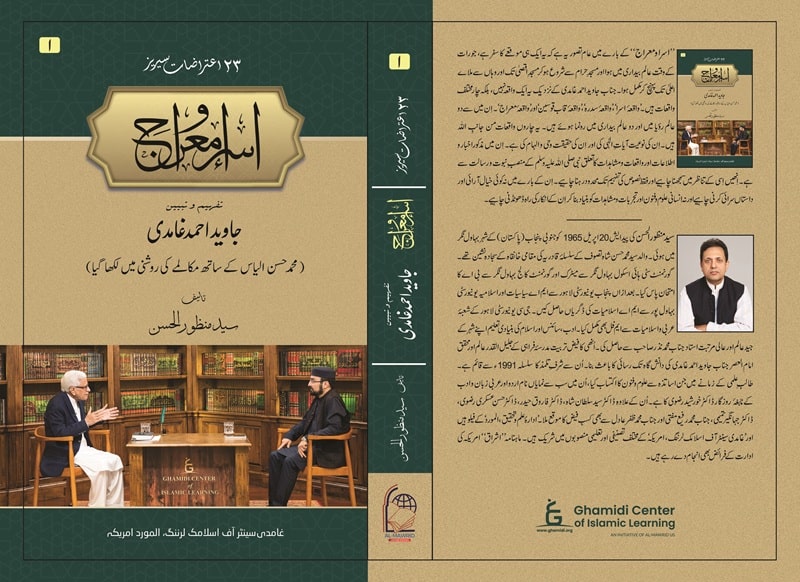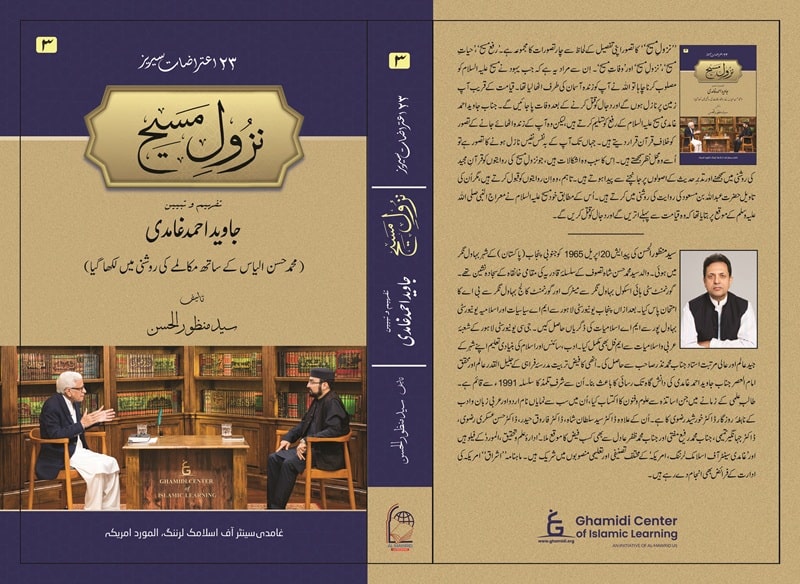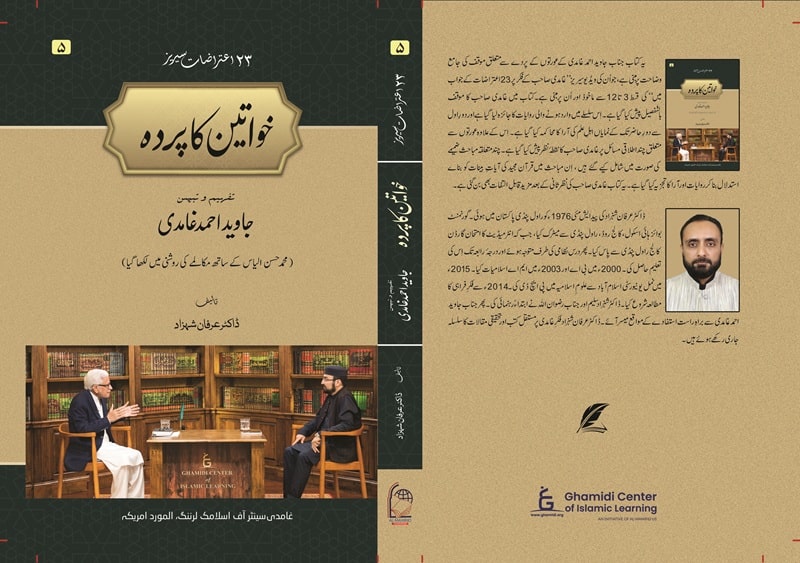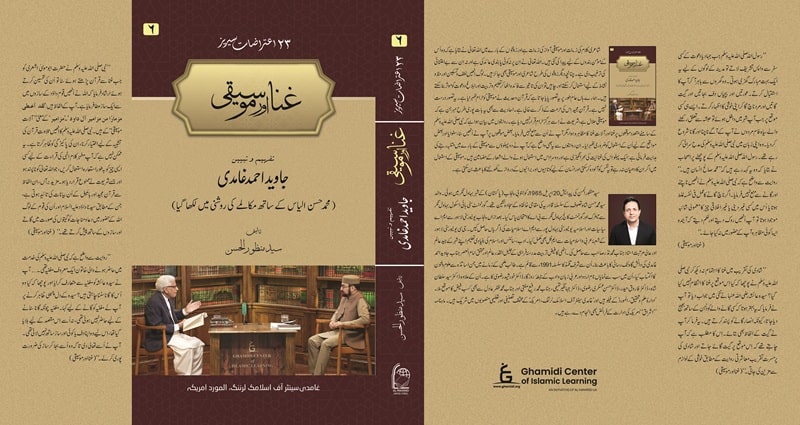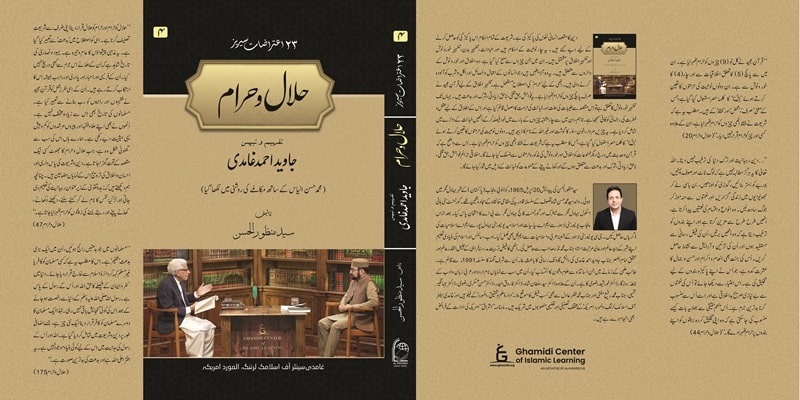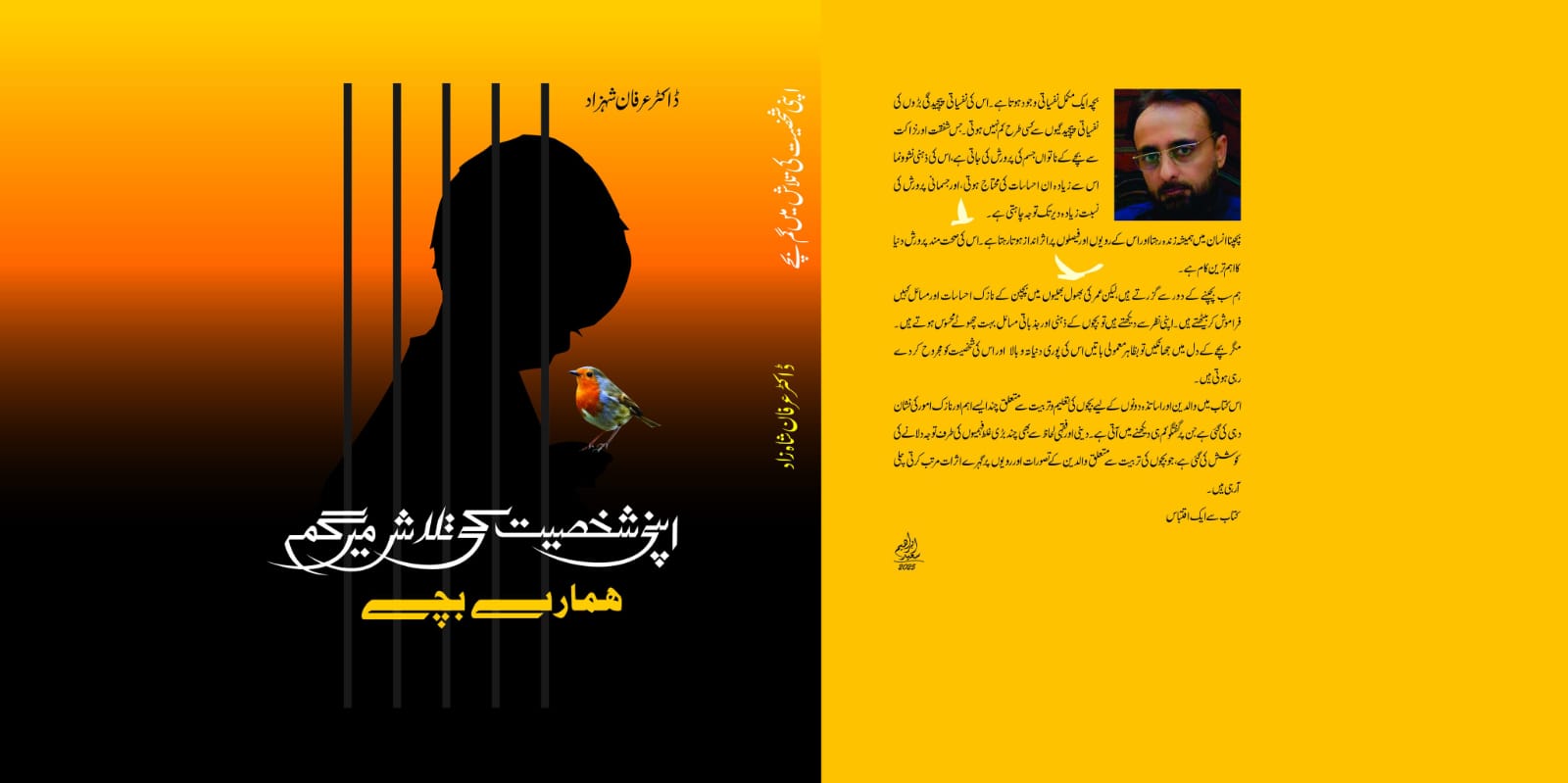Explore Our Curated Collection
Discover Free Books
The books are available free of cost for reading. However, all publication rights in every form are reserved exclusively for Ghamidi Center of Islamic Learning, Al-Mawrid US.
کتب مطالعے کے لیے بلا معاوضہ دستیاب ہیں۔ تاہم، ان کی ہر قسم کی اشاعت کے جملہ حقوق ’’غامدی سینٹر آف اسلامک لرننگ، المورد امریکہ‘‘ کے لیے محفوظ ہیں۔
Israʾ and Miʿraj
The present treatise, titled Israʾ wa Miʿraj, outlines the perspective of our esteemed teacher, Mr. Javed Ahmed Ghamidi, on this subject. It has been derived from episodes 34 to 37 of his video series Responses to the 23 Objections on Ghamidi’s Thought. This series addresses objections raised by traditional religious scholarship against Ghamidi’s views—objections often portrayed as deviations from the consensus of scholars and as isolated positions. In reality, these objections pertain to prevailing interpretations of various themes in the Qurʾan, Sunnah, Hadith, and Sirah. Javed Ahmed Ghamidi has rejected these interpretations, either partially or entirely, on the grounds that they conflict with the explicit texts of the Qurʾan and Sunnah and the established facts of Hadith and Sirah.
This series adopts a dialogical method of question-and-answer and discussion-based engagement. The interlocutor is Mr. Muhammad Hassan Ilyas, who has meticulously compiled and systematically presented the full range of issues to the teacher. In response, the esteemed teacher has elaborated upon the traditional viewpoint, critically examined its arguments, and presented his own position with comprehensive clarity.
The undersigned is currently compiling this series of discussions in the form of essays. To this end, the detailed discourses have been divided into segments, and concise allusions have been elucidated and expanded. Where appropriate, relevant excerpts from the teacher’s own writings have been incorporated. To aid explanation, clarification, support, and emphasis, references from the works of esteemed scholars have also been cited. The objective is to render these audio-visual discussions into written form, thereby facilitating access for students and researchers alike.
Mr. Shahid Mahmood has been assigned the task of assisting in the compilation, verification, and editorial refinement of the project. He is carrying out this responsibility with great diligence.
These essays reflect the undersigned’s understanding of the thoughts of the esteemed scholar and teacher. However, I am fortunate that they are also undergoing his review. As a result, major errors in interpretation and articulation are being rectified in real time.
To extract the scholarly discourse of the teacher on religious matters from his spoken dialogues and present it in writing—while benefiting from his principled guidance in the process—is an immense honour and distinction. It is a tremendous blessing from the Almighty, unquestionably far beyond the limits of my own capacity and merit. All praise is due to Allah.
The production of the aforementioned video series and the compilation of this essay series based upon it are both being carried out under the auspices of the Ghamidi Center of Islamic Learning, Al-Mawrid America. May God accept this collective endeavor of the institution and the individuals involved. Amen.
Shaq al-Qamar (The Splitting of the Moon)
This essay, titled Shaq al-Qamar, presents the viewpoint of the esteemed teacher Mr. Javed Ahmed Ghamidi. It is based on episodes 38 and 39 of his video series Responses to the 23 Objections on Ghamidi’s Thought. This series addresses critiques arising from traditional religious circles regarding Javed Ahmed Ghamidi’s interpretations, criticisms that are commonly presented as divergences from the consensus of classical scholars. In reality, these objections reflect prevailing understandings of various Qurʾanic, Sunnah-based, hadithic, and sirah-related themes, which Javed Ahmed Ghamidi has assessed and, on principled grounds, rejected either in part or in whole, contending that such interpretations contradict the explicit texts of the Qurʾan and Sunnah as well as the established facts of hadith and sirah.
The series adopts a dialogical approach, employing a format of structured question-and-answer and critical exchange. Mr. Muhammad Hassan Ilyas serves as the interlocutor, who has skillfully and comprehensively presented the entire range of objections to the teacher. In turn, Javed Ahmed Ghamidi has elaborated on the traditional viewpoints, critically examined their foundations, and articulated his own position with clarity and scholarly precision.
The undersigned is in the process of compiling these discussions into a series of essays. The detailed conversations have been systematically divided into thematic segments, concise references have been expanded upon, and nuanced points have been clarified. Where appropriate, relevant excerpts from Javed Ahmed Ghamidi’s own writings have been incorporated. To support the explanations and reinforce the arguments, references from the works of eminent scholars have also been provided. The primary objective is to make this content—currently available only in audio-visual form—accessible in written format, thereby facilitating engagement for students and researchers alike.
Mr. Shahid Mahmood has been assigned the responsibility of research assistance and is undertaking this role with commendable diligence. Supporting him in editing and compilation are Mr. Muʿazzam Safdar and Mr. Shahid Raza.
While these essays represent the undersigned’s understanding of Javed Ahmed Ghamidi’s thought, it is a matter of great privilege that they are also being reviewed by him. As a result, significant inaccuracies in interpretation or articulation are being corrected during the process of finalization.
To extract such profound scholarly discourse from Javed Ahmed Ghamidi’s dialogues and commit it to writing—with the benefit of his principled oversight—is a rare honor. It is a tremendous blessing from the Almighty, surely beyond the scope of my personal merit and ability. Alhamdulillah.
The development of this video series and the compilation of its essay-based counterpart are both being undertaken under the auspices of the Ghamidi Center of Islamic Learning, Al-Mawrid America. May God accept this collective endeavor of the institution and those involved. Amen
Nuzul-e-Masih (The Descent of Jesus)
This essay, titled Nuzul-e-Masih (The Descent of Jesus), articulates the position of the esteemed scholar Mr. Javed Ahmed Ghamidi. It is drawn from episodes 27 to 33 of his video series Responses to the 23 Objections on Ghamidi’s Thought. The series examines various criticisms emerging from traditional religious thought, which are often directed at Javed Ahmed Ghamidi’s interpretations and are typically framed as departures from the collective consensus of classical scholars. In essence, these critiques are rooted in conventional understandings of the Qurʾan, Sunnah, Hadith, and Sirah. Javed Ahmed Ghamidi has categorically rejected these interpretations—whether partially or entirely—on the grounds that they contradict the explicit teachings of the Qurʾan and Sunnah and the verified historical facts transmitted through hadith and sirah.
The methodology adopted in this discourse is dialogical, structured as an exchange of questions and discussions. The interlocutor, Mr. Muhammad Hassan Ilyas, has organized and presented all the questions comprehensively and with great clarity to the teacher. In his responses, Javed Ahmed Ghamidi has elucidated the traditional position, critically assessed its underlying arguments, and presented his own viewpoint with full clarity and scholarly rigor.
The undersigned is engaged in compiling these discussions in the form of written essays. For this purpose, the detailed content has been divided into manageable sections, with implicit references clarified and summarized points expanded. Wherever necessary, excerpts from Javed Ahmed Ghamidi’s own writings have been included. Additionally, references from the works of eminent scholars have been incorporated for explanation, corroboration, and reinforcement. The intent is to transform content currently available in audio-visual form into written form to facilitate accessibility for students and researchers.
Mr. Shahid Mahmood has been designated for research assistance and is fulfilling his role with commendable diligence. In the task of editing and compilation, he is joined by Mr. Muʿazzam Safdar and Mr. Shahid Raza, both of whom are contributing responsibly to this scholarly effort.
These essays reflect the undersigned’s own understanding of Javed Ahmed Ghamidi’s views. However, it is a matter of great good fortune that they are also being reviewed by him personally, allowing for timely correction of major interpretive or stylistic errors during the process.
To extract such refined theological discourse from Javed Ahmed Ghamidi’s dialogues and present it in written form—under his direct supervision—is a great honor and distinction. Indeed, it is a profound blessing from the Almighty, one that far exceeds the undersigned’s personal ability and worthiness. Alhamdulillah.
The production of this video series and the compilation of the related essays are being carried out under the auspices of the Ghamidi Center of Islamic Learning, Al-Mawrid America. May God accept this collective intellectual endeavor of the institution and all those involved. Amen.
Khawatin ka Pardah (The Veiling of Women)
This book presents a comprehensive explanation of Javed Ahmed Ghamidi’s position on the issue of pardah (veiling), and is based on episodes 3 to 12 of his video series Responses to the 23 Objections on Ghamidi’s Thought. This series addresses in detail those objections commonly raised against Javed Ahmed Ghamidi’s views, which are often portrayed as novel interpretations in contrast to the dominant religious narrative. The discussions center on traditional interpretations of the Qurʾan, Sunnah, and Hadith, which Javed Ahmed Ghamidi has examined through his principled and ijtihad-based lens. He has either partially or wholly rejected certain established views and has instead offered his own alternative readings.
Mr. Muhammad Hassan Ilyas has presented these objections to Javed Ahmed Ghamidi with great clarity and structure. In response, Javed Ahmed Ghamidi has not only defended his interpretations with sound reasoning but has also elucidated the traditional position and critically evaluated its underlying arguments. These discussions exemplify rigorous scholarship and impartial analysis.
Drawing from this series, the author has endeavored to compile a comprehensive volume focused exclusively on the subject of pardah. The debates have been organized into separate sections, core points have been clarified, new discussions have been added where relevant, and pertinent excerpts from Javed Ahmed Ghamidi’s published works have been included. Additionally, references from the writings of distinguished scholars have been cited to shed further light on various aspects of the topic.
The book has been further enriched through the review and revision of Javed Ahmed Ghamidi himself, enhancing its scholarly value and precision.
This project is being undertaken under the auspices of the Ghamidi Center of Islamic Learning, Al-Mawrid America. May Allah accept this collective effort and make it a means for the dissemination of religious knowledge and the elucidation of truth. Amen.
Singing and Music
The present writing under the title “Singing and Music” represents the position of our respected teacher, Javed Ahmed Ghamidi. It is derived from Episodes 58 to 67 of his video series “Responses to the 23 Objections on Ghamidi’s Thought.” This series addresses objections commonly raised from the standpoint of traditional religious thought against the views of Javed Ahmed Ghamidi, and which are typically framed as divergences from the consensus of the scholars. In reality, these objections pertain to prevalent interpretations of various discussions drawn from the Qurʾan, Sunnah, Hadith, and Sirah. Javed Ahmed Ghamidi has rejected many of these interpretations, either partially or entirely, on the grounds that they contradict the explicit texts of the Qurʾan and Sunnah and the established facts of Hadith and Sirah.
The mode of presentation in this discourse is dialogical, structured as a series of questions and answers. Mr. Muhammad Hassan Ilyas has served as the interlocutor in these discussions. He has organized and presented each topic to the esteemed teacher with great clarity and precision. In response, the teacher has elaborated upon the traditional viewpoint, analyzed its arguments, and offered a comprehensive and lucid exposition of his own perspective.
The author is presently compiling this series of discussions into a structured collection of articles. For this purpose, the detailed debates have been divided into manageable sections, with clarifications provided for brief remarks and expansions made where summaries had been offered. Where relevant, excerpts from the teacher’s own writings have been cited. To further elucidate and support the arguments, references from the works of eminent scholars have also been incorporated. The objective is to render the content of these audio-visual discussions accessible in written form, thereby facilitating ease of reference and study for students and researchers alike.
Mr. Shahid Mahmood has been assigned to assist with research for this project, a task he is performing with commendable diligence. In the editorial and compilation work, he is joined by Mr. Muʿazzam Safdar and Mr. Shahid Raza, who are also contributing effectively.
Although the articles represent the author’s understanding of the teacher’s views, it is a matter of good fortune that they are also being reviewed and revised by the teacher himself. As a result, significant errors in comprehension and presentation are being rectified in the process.
To derive scholarly content from the teacher’s spoken dialogues on religious topics and to do so under his principled supervision is a privilege and distinction. It is a great blessing from the Almighty—certainly far beyond the writer’s own ability and merit. All praise is due to God.
The production of this video series and the associated compilation of these articles is being carried out under the auspices of the Ghamidi Center of Islamic Learning, Al-Mawrid America. May God accept this collective effort of the institution and all individuals involved. Amen.
Halal-o- Haram (The Lawful and the Unlawful)
This essay, titled Halal-o-Haram (The Lawful and the Unlawful), presents the position of the esteemed scholar Mr. Javed Ahmed Ghamidi. It is based on episodes 40 to 42 of his video series Responses to the 23 Objections on Ghamidi’s Thought. In this series, the critiques commonly levelled against Javed Ahmed Ghamidi’s views by traditional religious scholarship are examined, critiques which are often portrayed as singular or deviant opinions when measured against the collective consensus of classical scholars. In reality, these criticisms pertain to the dominant interpretations of various discussions in the Qurʾan, the Sunnah, Hadith, and Sirah. Javed Ahmed Ghamidi, however, has found these interpretations to be inconsistent with the foundational texts of the Qurʾan and Sunnah and the established facts of hadith and sirah, and has consequently rejected them either in part or in full.
The format of the discourse is dialogical, structured around critical question-and-answer exchanges. The interlocutor is Mr. Muhammad Hassan Ilyas, who has skillfully and comprehensively presented each issue for discussion. Javed Ahmed Ghamidi, in turn, has clarified the traditional standpoint, analyzed the arguments in its support, and articulated his own position with clarity, depth, and evidence-based reasoning.
The undersigned is currently compiling these discussions into a series of essays. To facilitate this, the broader themes have been divided into sections, implicit allusions elaborated, and concise arguments expanded. Where relevant, passages from Javed Ahmed Ghamidi’s published works have been cited. To provide further context and validation, references to the works of distinguished scholars have also been included. The primary aim is to render these audio-visual discussions into written form so that students, scholars, and researchers may benefit from them more conveniently.
Research assistance for this project is being provided by Mr. Shahid Mahmood, who is carrying out his responsibilities with great care and dedication. He is joined in the editorial and compilation process by Mr. Muʿazzam Safdar and Mr. Shahid Riḍa.
While these essays represent the undersigned’s own understanding of Javed Ahmed Ghamidi’s ideas, it is a matter of great privilege that they are being reviewed by Javed Ahmed Ghamidi himself. As a result, significant inaccuracies in understanding or expression are being corrected in the course of finalization.
To derive such high-level scholarly discussions from the teacher’s dialogues and commit them to writing—under his direct guidance—is both an honor and a rare distinction. Indeed, this is a profound blessing from the Almighty, one that far exceeds the undersigned’s capabilities or merit. Alhamdulillah.
The production of the aforementioned video series and the compilation of these related essays is being undertaken under the auspices of the Ghamidi Center of Islamic Learning, Al-Mawrid America. May Allah accept this collective endeavor of the institution and all individuals involved. Amen.
Apni Shakhsiayt ki Talash main Gum Hamaray Bache
Apni Shakhsiayt ki Talash main Gum Hamaray Bache” is authored by Dr. Irfan Shehzad. This book highlights a number of important and sensitive issues concerning the education and training of children—topics that are seldom discussed. It also seeks to draw attention to certain major misconceptions from religious and jurisprudential perspectives that have long shaped parents’ ideas and attitudes toward child-rearing.
The book is divided into three sections: the first addresses educational training and related challenges; the second presents essays on the training of parents; and the third comprises jurisprudential articles deal with family issues.
